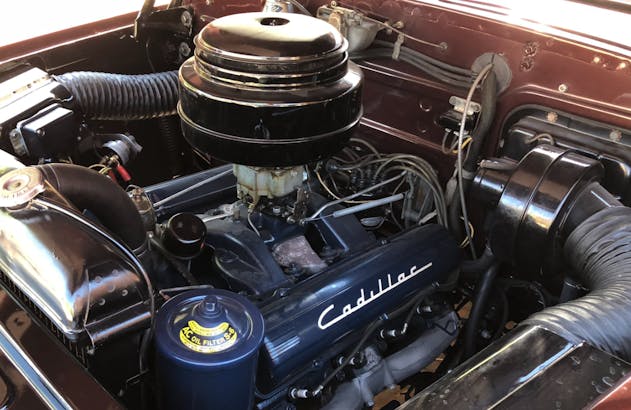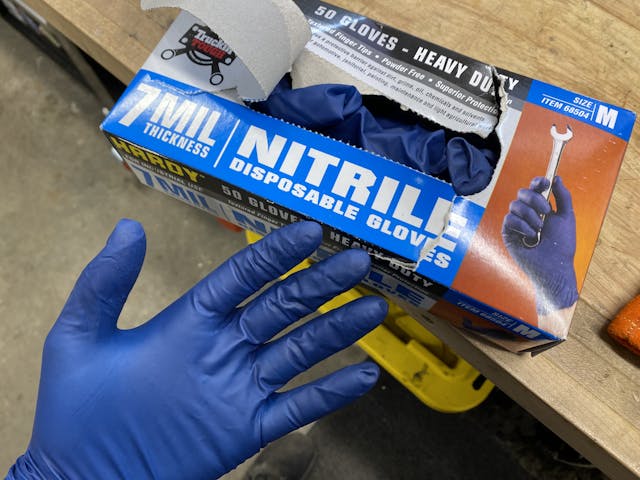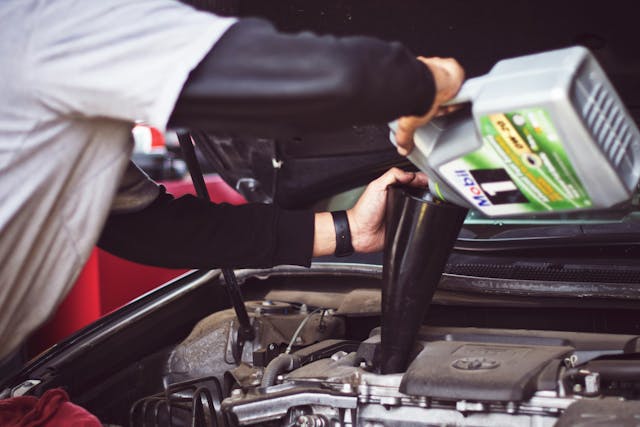8 oil change dos and don’ts
It’s a small job that somehow became a rite of passage for gearheads: Oil changes. The draining and refilling of engine oil is the first task that many budding wrench-turners undertake, and its certainly an important one. Like any other task in the automotive world, there are some pieces of institutional knowledge that comprise the key dos and don’ts for a smooth oil change. So let’s put these lessons learned out in the open, with the mission of shortening the process for newbies. And perhaps to reinforce some best practices for you veteran mechanics?
Don’t go crazy with warm-up

Modern oils are pretty amazing at suspending particles and contaminants, but there is still some junk that sinks down to the bottom of the pan. It needs to be stirred up to ensure it escapes when you pull the drain plug. Starting the engine and letting it idle for a minute or two is perfect for that final circulation. Run it any longer and you’re rewarded with nothing more than scalding hot oil that does nothing more than burn you. Before you pull that (drain) plug, give the engine a minute after shutting down, allowing the oil to drain to the pan from the nooks and crannies higher in the engine. But before you get underneath the vehicle to do the deed, remember you must…
Wear disposable gloves

Nitrile gloves keep you from soaking up solvents and oils into your skin. I’ve found 7mil thick to be a nice sweet spot of durable and affordable.
We all know the guy at the auto parts counter who has seriously gnarly hands from all the years being soaked in oil over decades of engine builds. That’s the visible damage. The invisible damage is sitting in your internal organs. All the hydrocarbons that get absorbed through the skin and are processed in our gut where they can’t be broken down. They end up accumulating in our body, which can cause serious health complications after years and years of chemical exposure. Preventing those issues is easy as putting on a pair of nitrile gloves. Use them even if it’s only for pulling the filter and drain plug, which you can do efficiently with…
The drain plug trick

It’s not groundbreaking, but nothing feels better than the perfect pull on a drain plug to ensure you don’t get any oil on your hand. The trick is pressure, not pulling. As you unthread the plug by hand, push in–against the bolt as in comes out–so the threads act as a seal with the outer edge. With a little practice you can get the pressure right (while not rocking the plug in the threads) and can spin the plug a full turn to feel for the “click.” That click means the bolt overlapped the last thread. With a swift motion away from the direction of oil flow, remove that now-loose plug. Presto! This can make thin viscosity oil changes much cleaner, and thick stuff like 20-50 can sometimes be spotless. In your excitement of not having a mess to clean up after draining, make sure you…
Don’t over tighten the drain plug or filter

It’s come to the point where stuck filters and stripped drain plugs are no longer a joke. Neither the filter nor plug require any real torque when installed properly. Use a small amount of oil to lube the filter’s rubber seal, then spin it into place. After the gasket seats on the housing, turn it only about three-quarter of an additional turn. Some applications might call for a full turn, but that is usually reserved for heavy duty equipment. Any tighter than what the filter manufacturers call for and you run the risk of deforming that rubber seal, which could cause oil to leak past the seal. That’s bad news. Any oil spillage is bad, so when you are filling…
Just use a funnel

The oil fill port on most engines is in that perfect spot where it looks like you could pour directly into it, except that’s a lie. They seem to be ideally located, but cleaning up if you miss (by even the smallest margin) can be a major pain. Are we really going to work so hard to spot and address leaks, to keep our engines clean, and just ruin it while doing routine maintenance?
I’m not. A funnel all but guarantees I won’t have to do any clean up after filling, even if I’m distracted or letting my 7 year-old niece do the filling. Putting in that fresh oil feels good, but be careful and…
Don’t overfill

This shows the rotating assembly without the oil pan and it’s easy to tell how oil at too high of a level would be bad.
Too much oil is just as bad as not enough. Seriously. The oil level in a wet-sump engine is carefully calculated to keep the rotating assembly from whipping through the oil. That action causes foaming, and oil foam pushed through the oiling system is the same as not having oil at all. I don’t need to tell you how bad that can be, so check the service or owners manual for the proper fill level. When done, look at the dipstick as a double check. Luckily, the empty oil containers you now have at this point are are perfect to…
Recycle your used oil

It’s never been easier to properly recycle used oil, so there is no excuse to do otherwise. Just about any auto parts store takes it, so they should be your first trip in your freshly serviced vehicle to “return” your oil. Be sure to capture oil in a non-contaminated pan so that the oil can actually be recycled. Coolant is the main enemy here, so be sure to flush your drain pan before the oil change. Luckily you don’t have to worry about how dusty or dirty the pan is, but other fluids can defeat the purpose of recycling. But before you make the trip to recycle the oil, be sure to…
Reset the computer (or write down your service date)

Modern cars have an oil life monitoring system. Whether you trust it is a personal preference, but for the sake of eliminating confusion, go ahead and reset it now. Most reset procedures involves cycling the ignition key and pressing the throttle pedal a certain number of times. The service manual will outline it, or a quick search to an online make/model specific forum will have the instructions. If your vehicles are of the manual variety, write down the oil change date in a log book. Or consider service tracker kept in the car or garage, as it keeps you from forgetting what’s been done. Not to mention thisa paper trail shows good stewardship to a potential next owner, which can mean an easier sale for more money.
In all, oil changes can be simple and rewarding for newbies and DIY enthusiasts alike. Following these best practices will not only keep your vehicle happy, but also make the experience better for you each time. Do you have something specific you add to this process? Let us know about it in the comments below.
***
Check out the Hagerty Media homepage so you don’t miss a single story, or better yet, bookmark it. To get our best stories delivered right to your inbox, subscribe to our newsletters.



I DOUBLE the comments about safety glasses and especially jack stands! Nary a peep in the article yet THE most important tip cuz it could save your life! You’ve heard the stories of some weekend do-it-yourselfer rigging up some odd way to hoist up their vehicle, say cinder blocks or milk crates, you name it, only to have it come down atop them while crawling under the thing? This is the main reason why the 10-minute oil change stations are so popular IMHO.
All excellent tips. I always take the oil filler cap off and put it somewhere conspicuous like on the bonnet catch before I drain the oil so I remember to refill. Easy to get distracted.
Make sure you can get the new oil in the engine. I had an old Isuzu Trooper that I could slide under without jacking it up to remove the plug and filter while the oil was still warm from the drive home. Went to pull the hood release and the cable came off in my hand! Empty sump, drain pan full of oil and no way to raise the hood. This was before YouTube so it was a full Saturday figuring out how to get the hood open without breaking the grille. I finally did it. Whew. Since then step #1 for me is raise the hood and loosen the filler cap. Then drain the oil.
Make sure to replace the drain plug crush washer and torque to factory specs. Some oil filters have torque specs as well like the one for my Moto Guzzi. So be sure to torque them to spec as well rather than using the 3/4 turn method, or you may wish you had.
i use a china marker and write following on area under hood, engine cover, coolant tank, wherever.
Date/odometer reading/viscosity and brand
Just a quick reminder for me checking oil level or filling wiper tank
Write with a Sharpe on the underside of the hood or on the radiator support the size of the drain plug. How many times ( especially if you own more than one car) have you had to climb out from under the car because you started with the wrong size wrench for the drain plug.
My “96 Supercharged Miata gets about 4-5K year, so every fall before I put it up the oil and filter gets changed.
I like to set the drain plug on top of the filler cap while the oil drains – hard to forget it that way.
Kyle, thanks for this article. So many “Oil Can” jerks over tighten the filter and the drain plug..the next guy will be cussing them out.
I change mine and rotate my tires every 5,000 miles. Although I always write it down, I just look at the odometer and if it is divisible by 5,000, it’s time to change. A few hundred miles one way or another won’t make a difference. I just go back to my 5,000 division rule next time.
If you hate dropping the drain plug into a pan full of hot oil, then get a Drain Plug Pro: https://www.otctools.com/products/drain-plug-pro-0
It’s a magnet on the end of a flexible shaft that attaches to the plug. Break the plug loose with a wrench, attach the tool, and spin out the plug with your hand a safe distance away. Your hand stays clean, and the plug stays out of the drain pan. Works like a charm!
Here’s another tip: It’s often hard to tell when you’ve tightened the filter 3/4 of a turn, especially if it’s in a hard place to see. I always take a Sharpie and write numbers 1-4 spaced evenly around the circumference of the filter. When the gasket makes first contact, I note the number that’s visible, then continue to tighten three more numbers. For example, if “1” is visible at first contact, tighten until “4” is visible. If “3” is visible at first contact, tighten until “2” is visible. No more over- or under-tightened filters.
As an automotive instructor of 35 years, I have supervised or done thousands of oil changes. The best advice for tightening a spin on oil filter, after you oil the gasket, is to tighten the filter hand tight. This method of torquing has worked with ZERO failures no matter what the size of the student.
Some great comments. I also use the magnet for the drain plug. On a few of my cars, the oil filter is upside down. I use Baldwin filters which have a check valve so oil never leaks and I can prefill. I also use magic marker to date the oil change date on the filter. As the filter is on top, each time I open the hood, I can check the date. Ditto for the air filter, which I always change with oil change. Two items I don’t think have been mentioned. I put a small plastic bag from the supermarket (hey we get charged 5cents per bag) over the oil filter, so It never gets touched and an oil that may leak out of the filter is “in the bag”. On a few of my cars, the drain plug is on the side and I use a flexible rubber oil splash guard on the side of the funnel so that first burst of oil stays in the funnel.
I have a ’92 Mustang LX 5.0 with 91,000 miles that doesn’t get driven very much. I used to change the oil annually, but now change the oil every two years with less than 150 miles put on the car between changes. A buddy told me that because I live in a part of the country that experiences a range of temperatures that are only above the freezing point (Phx AZ) I could get away with this longer time interval between changes. In this car I use conventional oil. Lots of experts out there – what do you folks think?
Dearest TedGoodWood,
Live a little and drive your car more.
That is my expert opinion.
All the best,
Justin
Short drives that end before the oil gets up to operating temperature are very bad for the engine as the contaminates don’t burn off and stay in the oil. Change your oil at LEAST once per year .
As previously stated, be sure to fill the new filter as full as possible with oil. Make certain you lube the gasket on the new filter to prevent sticking and the resultant cursing at the next removal. Easy on the torque when you install the new filter. Contact plus 3/4 turn can be a bit much.
I always keep a supply of the drain plug o-ring
I think what you neglected to say when I used to change oil in BMWs and Porsches you don’t want to become complacent and have somebody come up and start shooting the shit with you thus distract you and you forget to tighten the drain plug, ViceVersa forget to place the oil back in the engine before you start the car back up. Make sure you count as many empty oil cans before starting the engine and check the dip stick before starting. You can also prime the oil filter by filling the filter Cartilage up 2/3 of the way before you screw it back on. When I was doing this type of service and somebody came up to me, I refuse to talk to them until I made sure I completed the task at hand so that I didn’t become complacent.